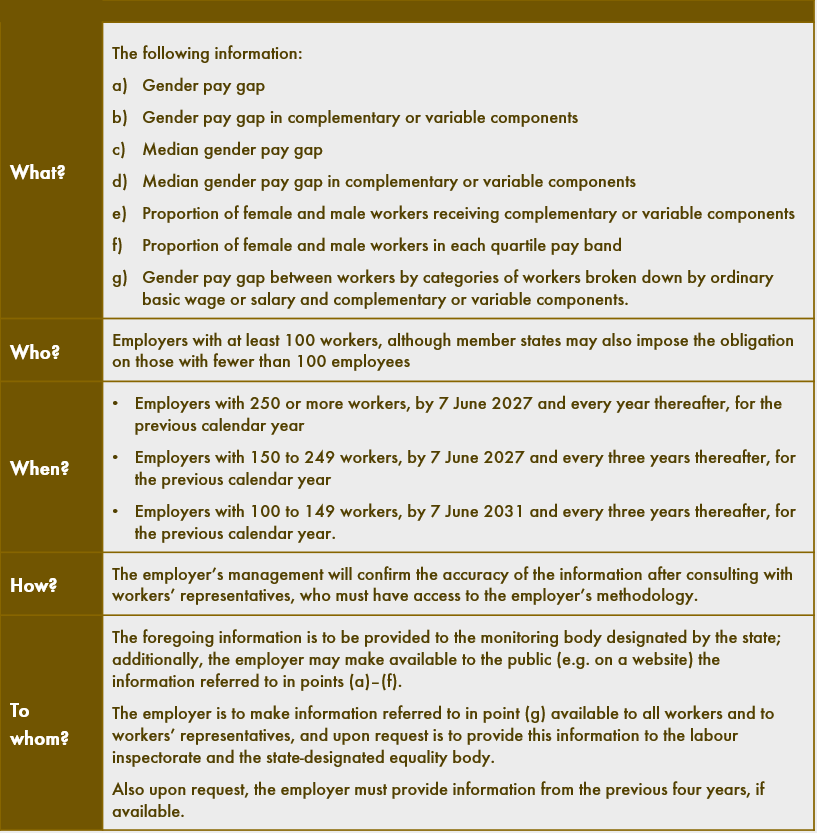Pay Transparency Directive: Strengthening the principle of equal pay in the European Union
Directive (EU) 2023/970 of the European Parliament and of the Council to strengthen the application of the principle of equal pay for equal work or work of equal value between men and women through pay transparency and enforcement mechanisms was adopted on 10 May 2023. What new obligations will employers face? How does EU law understand equal pay?
The principle of equal pay in EU law
Equal pay for men and women is rooted in the Treaty on the Functioning of the European Union. Art. 157 TFEU imposes on member states the obligation to ensure equal pay by eliminating gender discrimination in pay. This key premise also underpins Directive 2023/970.
The treaty introduces the obligation to ensure equal pay for equal work and work of equal value, clarifying that equal pay without discrimination based on sex means that:
- Pay for the same work at piece rates shall be calculated on the basis of the same unit of measurement
- Pay for work at time rates shall be the same for the same job.
For better implementation of these obligations, the treaty establishes an explicit ban on gender discrimination in pay. However, it allows for affirmative action aimed at equalising opportunities for the underrepresented sex by preventing and compensating for disadvantages in professional careers.
But despite many efforts at the national and EU levels, pay inequality remains a challenge. The Pay Transparency Directive is another attempt to eradicate this harmful practice.
General provisions of the directive
The directive will apply to employers in both private and public sectors. The guarantees apply to workers in an employment relationship, taking into account the case law from the Court of Justice of the European Union in this regard. Some solutions will also apply to job applicants.
Like the TFEU, the directive uses the concepts of “equal work” and “work of equal value.” The European Parliament has enacted more detailed criteria for determining whether two people are performing work that is equal or equal in value. In principle, these are objective, gender-neutral criteria. They include:
- Skills
- Effort
- Responsibilities and working conditions
- Where applicable, any other factors relevant in a particular job or position, in particular soft skills.
Only by applying all of these criteria together can a full assessment be made of whether two workers are in a comparable situation.
The new directive is intended to strengthen the application of the principle of equal pay by introducing two key mechanisms: pay transparency and enforcement of equal pay entitlements.
Pay transparency
The directive requires employers in the European Union to provide pay transparency. Among other things, this means that workers will have the right to information on the average pay for a particular job. This will make it easier to identify cases of inequality and pay discrimination. This mechanism is intended not only to increase transparency, but also to enable workers to effectively defend their rights if violations are found in this area.
Right to information prior to employment
With respect to applicants for employment, employers will be required to provide information on:
- The starting pay, or range, for the position
- Where applicable, the collective agreement applicable to the position.
This information is to be provided in a manner ensuring informed and transparent pay negotiations, e.g. in a published job vacancy notice, which ensures gender equality in the recruitment process.
Additionally, the directive prohibits asking applicants about their pay history in any previous employment.
Right to information during employment
The member states will have to introduce provisions requiring employers to provide easy access to objective and gender-neutral criteria applied to determine workers’ pay, pay levels and pay progression (for progression, member states may exempt from this duty employers with fewer than 50 workers).
The directive also establishes the worker’s right to two types of information from the employer:
- At the worker’s request, information in writing on their individual pay level and the average pay levels, broken down by sex, for categories of workers performing the same work as them or work of equal value to theirs, within a maximum of two months from submission of the request (in case of deficiencies in the information provided, the employer will have to clarify the information at the request of the worker or the organisation representing the worker)
- Annual information to employees about the foregoing entitlement and the procedure for implementing it.
Employers will have to provide this information in a format accessible to people with disabilities, taking into account their special needs.
Pay transparency
The member states are required to enact provisions banning the use of contractual clauses preventing workers from disclosing their pay. This means that national legal systems are to be equipped with provisions explicitly preventing pay confidentiality clauses.
At the same time, employers can require workers not to use information other than about their own pay and pay level for any purpose other than exercising their right to equal pay.
Wage gap reporting
The directive requires employers to report data on pay inequality, as outlined in the table below.

Workers, workers’ representatives, labour inspectorates and equality bodies have the right to ask the employer for additional clarifications and details of the information indicated in the table, and the employer must respond within a reasonable time.
If the pay gap is not justified by objective, gender-neutral criteria, employers will be required to take remedial measures within a reasonable time, in close cooperation with workers’ representatives, the labour inspectorate or the equality body.
Joint pay assessment
Employers obliged to conduct the foregoing reporting will have to conduct a joint wage assessment with workers’ representatives when all of the following conditions are met:
- The pay reporting demonstrates a difference in the average pay level between female and male workers of at least 5% in any category of workers
- The employer has not justified such a difference in the average pay level on the basis of objective, gender-neutral criteria
- The employer has not remedied such an unjustified difference in the average pay level within six months of the submission of the pay reporting.
Assessments are to be carried out to identify, remedy and prevent differences in pay between female and male workers not justified by objective, gender-neutral criteria. The evaluation will consist of:
- An analysis of the proportion of female and male workers in each category of workers
- Information on average female and male workers’ pay levels and complementary or variable components for each category of workers
- Any differences in average pay levels between female and male workers in each category of workers
- The reasons for such differences in average pay levels, on the basis of objective, gender-neutral criteria, if any, as established jointly by the workers’ representatives and the employer
- The proportion of female and male workers who benefited from any improvement in pay following their return from maternity or paternity leave, parental leave or carers’ leave, if such improvement occurred in the relevant category of workers during the period in which the leave was taken
- Measures to address differences in pay if they are not justified on the basis of objective, gender-neutral criteria
- An evaluation of the effectiveness of measures from previous joint pay assessments.
The joint pay assessment will be made available to workers and their representatives, communicated to the monitoring body and, upon request, made available to the labour inspectorate and also to the equality body in the member state.
After the joint pay assessment, in cooperation with workers’ representatives and within a reasonable time, employers will be required to implement remedial measures.
The member states are to ensure that employers have access to tools and methods to easily draw up and apply gender-neutral job evaluation and grading systems that exclude any gender-based pay discrimination.
Additionally, the directive provides for training and technical assistance to employers with fewer than 250 workers to effectively implement the obligations imposed by the directive.
Enforcement mechanisms
The directive strengthens the mechanisms for enforcing the right to equal pay. The member states will be required to introduce sanctions for violations of equal pay provisions so that employers implement the principle of equal pay to the fullest extent possible. These mechanisms will include both financial sanctions and other measures to induce employers to take active steps to eliminate pay inequality.
In addition to a system of sanctions, the directive emphasises the need to provide a legal avenue for workers harmed by employers’ discriminatory actions. The member states are also to ensure that associations and other organisations with a legitimate interest in ensuring equality between men and women may represent workers in such proceedings.
If there is a finding of gender discrimination in pay, the worker should receive compensation or reparation in an appropriate amount, corresponding to the actual damage, not limited in advance by the member state.
In the context of proceedings, the states should reverse the burden of proof and place it on the employer sued for direct or indirect pay discrimination, particularly if the employer fails to meet its obligations under the directive. Additionally, courts and other bodies conducting proceedings should be equipped with the possibility to obtain evidence at the employer’s disposal.
The directive also provides protection against adverse treatment for workers exercising their rights.
Conclusion
The Pay Transparency Directive is an important step towards realising the principle of equal pay between men and women in the European Union. By introducing pay transparency and enforcement mechanisms, the directive aims not only to reduce pay inequality, but also to build a fairer and more sustainable economy based on equality of opportunity and treatment. However, the new directive poses a number of additional reporting challenges, especially for the largest employers.
The member states have to implement the directive by 7 June 2026.
The article was first published on hrlaw.pl blog
Dr hab. Marcin Wujczyk, attorney-at-law, Employment Law practice, Wardyński & Partners
